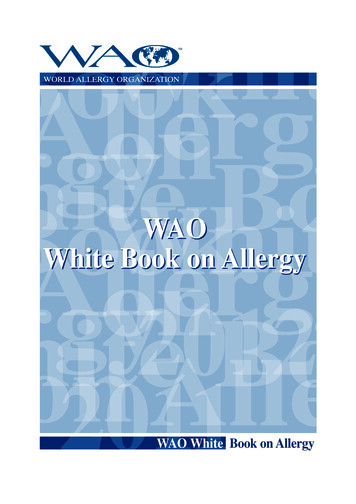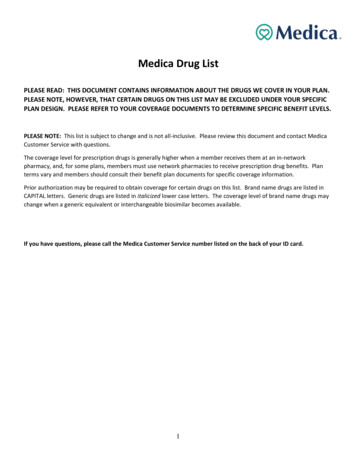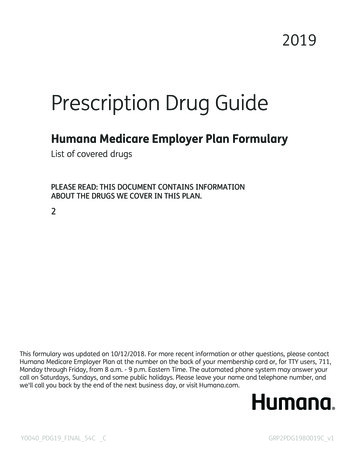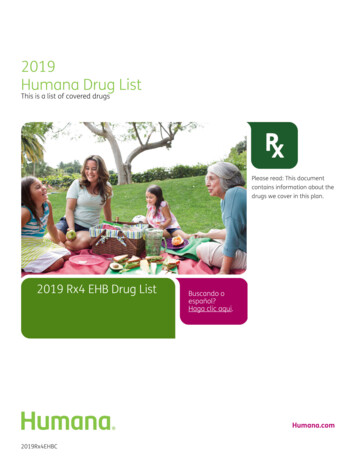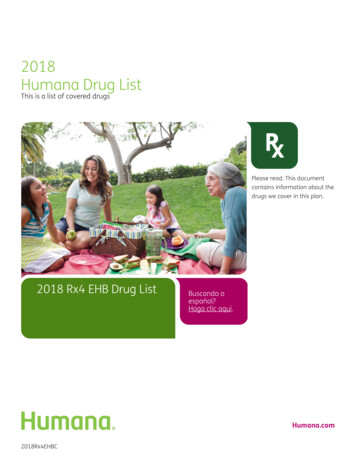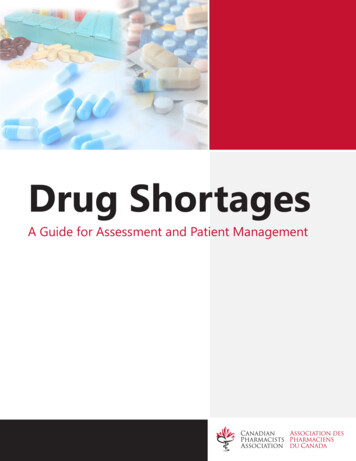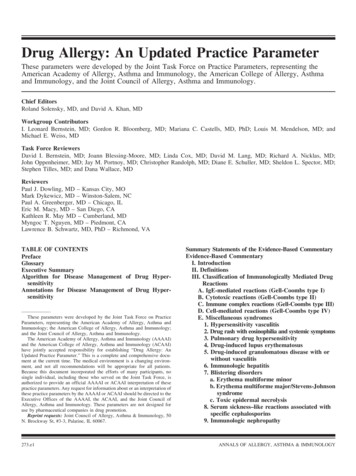
Transcription
Drug Allergy: An Updated Practice ParameterThese parameters were developed by the Joint Task Force on Practice Parameters, representing theAmerican Academy of Allergy, Asthma and Immunology, the American College of Allergy, Asthmaand Immunology, and the Joint Council of Allergy, Asthma and Immunology.Chief EditorsRoland Solensky, MD, and David A. Khan, MDWorkgroup ContributorsI. Leonard Bernstein, MD; Gordon R. Bloomberg, MD; Mariana C. Castells, MD, PhD; Louis M. Mendelson, MD; andMichael E. Weiss, MDTask Force ReviewersDavid I. Bernstein, MD; Joann Blessing-Moore, MD; Linda Cox, MD; David M. Lang, MD; Richard A. Nicklas, MD;John Oppenheimer, MD; Jay M. Portnoy, MD; Christopher Randolph, MD; Diane E. Schuller, MD; Sheldon L. Spector, MD;Stephen Tilles, MD; and Dana Wallace, MDReviewersPaul J. Dowling, MD – Kansas City, MOMark Dykewicz, MD – Winston-Salem, NCPaul A. Greenberger, MD – Chicago, ILEric M. Macy, MD – San Diego, CAKathleen R. May MD – Cumberland, MDMyngoc T. Nguyen, MD – Piedmont, CALawrence B. Schwartz, MD, PhD – Richmond, VATABLE OF CONTENTSPrefaceGlossaryExecutive SummaryAlgorithm for Disease Management of Drug HypersensitivityAnnotations for Disease Management of Drug HypersensitivityThese parameters were developed by the Joint Task Force on PracticeParameters, representing the American Academy of Allergy, Asthma andImmunology; the American College of Allergy, Asthma and Immunology;and the Joint Council of Allergy, Asthma and Immunology.The American Academy of Allergy, Asthma and Immunology (AAAAI)and the American College of Allergy, Asthma and Immunology (ACAAI)have jointly accepted responsibility for establishing “Drug Allergy: AnUpdated Practice Parameter.” This is a complete and comprehensive document at the current time. The medical environment is a changing environment, and not all recommendations will be appropriate for all patients.Because this document incorporated the efforts of many participants, nosingle individual, including those who served on the Joint Task Force, isauthorized to provide an official AAAAI or ACAAI interpretation of thesepractice parameters. Any request for information about or an interpretation ofthese practice parameters by the AAAAI or ACAAI should be directed to theExecutive Offices of the AAAAI, the ACAAI, and the Joint Council ofAllergy, Asthma and Immunology. These parameters are not designed foruse by pharmaceutical companies in drug promotion.Reprint requests: Joint Council of Allergy, Asthma & Immunology, 50N. Brockway St, #3-3, Palatine, IL 60067.273.e1Summary Statements of the Evidence-Based CommentaryEvidence-Based CommentaryI. IntroductionII. DefinitionsIII. Classification of Immunologically Mediated DrugReactionsA. IgE-mediated reactions (Gell-Coombs type I)B. Cytotoxic reactions (Gell-Coombs type II)C. Immune complex reactions (Gell-Coombs type III)D. Cell-mediated reactions (Gell-Coombs type IV)E. Miscellaneous syndromes1. Hypersensitivity vasculitis2. Drug rash with eosinophilia and systemic symptoms3. Pulmonary drug hypersensitivity4. Drug-induced lupus erythematosus5. Drug-induced granulomatous disease with orwithout vasculitis6. Immunologic hepatitis7. Blistering disordersa. Erythema multiforme minorb. Erythema multiforme major/Stevens-Johnsonsyndromec. Toxic epidermal necrolysis8. Serum sickness–like reactions associated withspecific cephalosporins9. Immunologic nephropathyANNALS OF ALLERGY, ASTHMA & IMMUNOLOGY
F. Other classification systems for drug allergyIV. Risk FactorsV. Clinical Evaluation and Diagnosis of Drug AllergyA. HistoryB. Physical examinationC. General clinical testsD. Specific testsE. Tissue diagnosisVI. Management and Prevention of Drug AllergicReactionsA. GeneralB. Induction of drug toleranceC. Immunologic IgE induction of drug tolerance(drug desensitization)D. Immunologic non-IgE induction of drug tolerancefor nonanaphylactic reactionsE. Pharmacologic induction of drug tolerance (eg,aspirin desensitization)F. Undefined induction of drug toleranceG. Graded challengeVII. Specific DrugsA. -Lactam antibiotics1. Penicillin2. Ampicillin and amoxicillin3. Cephalosporins4. Cephalosporin administration to patients with ahistory of penicillin allergy5. Penicillin administration to patients with ahistory of cephalosporin allergy6. Monobactams (aztreonam)7. CarbapenemsB. Non– -lactam antibioticsC. Antimycobacterial drugsD. Diabetes medicationsE. Cancer chemotherapeutic agentsF. Human immunodeficiency virus (HIV) medicationsG. Disease-modifying antirheumatic drugs (DMARDs)H. Immunomodulatory agents for autoimmune diseasesI. Modifying drugs for dermatologic diseasesJ. Perioperative agentsK. Blood and blood productsL. OpiatesM. CorticosteroidsN. ProtamineO. HeparinP. Local anestheticsQ. Radiocontrast media (RCM)R. Aspirin and nonsteroidal anti-inflammatory drugs(NSAIDs)S. Angiotensin-converting enzyme (ACE) inhibitorsT. Biologic modifiers1. Cytokines2. Anti–TNF- drugs3. Monoclonal antibodies4. Omalizumab5. Anticancer monoclonal antibodiesVOLUME 105, OCTOBER, 2010U. Complementary medicinesV. Other agentsCONTRIBUTORSThe Joint Task Force has made a concerted effort to acknowledge all contributors to this parameter. If any contributorshave been excluded inadvertently, the Task Force will ensurethat appropriate recognition of such contributions is madesubsequently.CHIEF EDITORSRoland Solensky, MDDivision of Allergy and ImmunologyThe Corvallis ClinicCorvallis, OregonDavid A. Khan, MDProfessor of MedicineDivision of Allergy & ImmunologyUniversity of Texas Southwestern Medical CenterDallas, TexasWORKGROUP CONTRIBUTORSI. Leonard Bernstein, MDProfessor of Clinical MedicineUniversity of Cincinnati College of MedicineCincinnati, OhioGordon R. Bloomberg, MDAssociate Professor, Department of PediatricsDivision of Allergy & Pulmonary MedicineWashington University School of MedicineSaint Louis, MissouriMariana C. Castells, MD, PhDDirector, Desensitization ProgramAssociate Director, Allergy Immunology Training ProgramBrigham & Women’s HospitalHarvard Medical SchoolBoston, MassachusettsLouis M. Mendelson, MDClinical ProfessorUniversity of ConnecticutPartner, Connecticut Asthma & Allergy Center, LLCWest Hartford, ConnecticutMichael E. Weiss, MDClinical Professor of Medicine,University of Washington, School of MedicineSeattle, WashingtonTASK FORCE REVIEWERSDavid I. Bernstein, MDDepartment of Clinical Medicine, Division of ImmunologyUniversity of Cincinnati College of MedicineCincinnati, OhioJoann Blessing-Moore, MDDepartment of ImmunologyStanford University Medical CenterPalo Alto, California273.e2
Linda Cox, MDDepartment of MedicineNova Southeastern UniversityDavie, FloridaDavid M. Lang, MDAllergy/Immunology Section, Division of MedicineCleveland Clinic FoundationCleveland, OhioRichard A. Nicklas, MDDepartment of MedicineGeorge Washington Medical CenterWashington, DCJohn Oppenheimer, MDDepartment of Internal MedicineNew Jersey Medical SchoolMorristown, New JerseyJay M. Portnoy, MDSection of Allergy, Asthma & ImmunologyThe Children’s Mercy HospitalUniversity of Missouri-Kansas City School of MedicineKansas City, MissouriChristopher Randolph, MDCenter for Allergy, Asthma and ImmunologyYale HospitalWaterbury, ConnecticutDiane E. Schuller, MDDepartment of PediatricsPennsylvania State UniversityMilton S. Hershey Medical CollegeHershey, PennsylvaniaSheldon L. Spector, MDDepartment of MedicineUCLA School of MedicineLos Angeles, CaliforniaStephen A. Tilles, MDDepartment of MedicineUniversity of Washington School of MedicineRedmond, WashingtonDana Wallace, MDDepartment of MedicineNova Southeastern UniversityDavie, FloridaInvited ReviewersPaul J. Dowling, MD – Kansas City, MOMark S. Dykewicz, MD – Winston Salem, NCPaul A. Greenberger, MD – Chicago, ILEric M. Macy, MD – San Diego, CAKathleen R. May, MD – Cumberland, MDMyngoc T. Nguyen, MD – Piedmont, CAAd Hoc ReviewersLawrence B. Schwartz, MD273.e3AcknowledgmentsThe Joint Task Force wishes to acknowledge the followingindividuals who also contributed substantially to the creationof this parameter: Erin Shae Johns, PhD, and Jessica Karle,MS, for their immense help with formatting and restructuringthis document; Susan Grupe for providing key administrativehelp to the contributors and reviewers of this parameter; andBrett Buchmiller, MD, for his assistance in creating thealgorithms in this parameter.PREFACEThe objective of “Drug Allergy: An Updated Practice Parameter” is to improve the care of patients by providing thepracticing physician with an evidence-based approach to thediagnosis and management of adverse drug reactions. Thisdocument was developed by a Working Group under theaegis of the Joint Task Force on Practice Parameters, whichhas published 26 practice parameters and updated parametersfor the field of allergy/immunology (these can be foundonline at www.jcaai.org). The 3 national allergy and immunology societies—the American Academy of Allergy,Asthma and Immunology (AAAAI), the American College ofAllergy, Asthma and Immunology (ACAAI), and the JointCouncil of Allergy, Asthma and Immunology (JCAAI)—have given the Joint Task Force the responsibility for bothcreating new parameters and updating existing parameters.This parameter builds on “Disease Management of DrugHypersensitivity: A Practice Parameter,” which was published in 1999 by the Joint Task Force on Practice Parameters. It follows the same general format as that document,with some substantive changes reflecting advancements inscientific knowledge and their effect on management of drugallergy. This document was written and reviewed by specialists in the field of allergy and immunology and was exclusively funded by the 3 allergy and immunology organizationsnoted above.A Working Group chaired by Roland Solensky, MD, prepared the initial draft, which was then reviewed by the JointTask Force. A comprehensive search of the medical literaturewas conducted using Ovid MEDLINE and the CochraneDatabase and Keywords relating to drug allergy. Publishedclinical studies were rated by category of evidence and usedto establish the strength of clinical recommendations. Theworking draft of “Drug Allergy: An Updated Practice Parameter” was reviewed by a large number of experts in allergyand immunology. These experts included reviewers appointed by the AAAAI and ACAAI. The authors carefullyreviewed and considered additional comments from thesereviewers. The revised final document presented here wasapproved by the sponsoring organizations and represents anevidence-based; broadly accepted consensus parameter.This updated parameter contains several significantchanges from the original parameter on “Disease Management of Drug Hypersensitivity: A Practice Parameter.” Thetitle of the parameter was changed from drug hypersensitivityto drug allergy. In this updated parameter the term drugANNALS OF ALLERGY, ASTHMA & IMMUNOLOGY
allergy is defined as an immunologically mediated responseto a pharmaceutical and/or formulation (excipient) agent in asensitized person. The implication is that drug allergy doesnot simply include only IgE-mediated reactions. Anothersignificant change is the introduction of the new term induction of drug tolerance to encompass classic IgE-mediateddrug desensitizations and other non–IgE-mediated “desensitization” procedures for various medications. In addition,several new sections have been added, including a new glossary with new terms, new classifications and subclassifications for drug reactions, and new sections on drug allergic reactions to chemotherapeutic agents, corticosteroids,disease-modifying antirheumatic drugs, antimycobacterialdrugs, biologic modifiers, immunosuppressive agents, immunomodulatory agents, complementary medications, and druginduced granuloma with or without vasculitis. Significantupdates to sections on cutaneous manifestations of drug reactions, laboratory testing, -lactam allergy, cross-reactivitybetween carbapenems and penicillin, and human immunodeficiency virus medications have been added. Finally, a number of protocols for induction of drug tolerance procedureshave been added.The Executive Summary emphasizes the key updates sincethe 1999 drug hypersensitivity parameter. This ExecutiveSummary has been significantly expanded to include the newsections and highlight the major updates to this parameter. Itshould be noted that the Executive Summary does not discussall of this parameter’s topics in depth. An annotated algorithm in this document summarizes the major decision pointsfor the evaluation and treatment of patients who have experienced possible adverse drug reactions (Fig 1). This is followed by a list of summary statements that represent the keypoints to consider in the evaluation and management of drughypersensitivity reactions. Within the evidence-based commentary, the summary statements are repeated and are followed by the text that supports that summary statement. Theevidence-based commentary first discusses general issuesrelating to drug allergy, including definitions, classifications,risk factors, and the general approach to evaluation, diagnosis, management, and prevention (sections I through VI).Subsequently, specific types of drugs are discussed (sectionVII).The Joint Task Force on Practice Parameters would like tothank the AAAAI, ACAAI, and JCAAI, who supported thepreparation of the updated parameter, and the large number ofindividuals who have so kindly dedicated their time and effortto the preparation and review of this document.GLOSSARY Adverse drug reactions include all unintended pharmacologic effects of a drug except therapeutic failures, intentional overdosage, abuse of the drug, or errors in administration. They can be classified as predictable orunpredictable. Unpredictable reactions are further subdivided into drug intolerance, drug idiosyncrasy, drug allergy, and pseudoallergic reactions.VOLUME 105, OCTOBER, 2010 Drug allergy is an immunologically mediated response toa pharmaceutical and/or formulation (excipient) agent in asensitized person. Anaphylaxis is an immediate systemic reaction that occurswhen a previously sensitized individual is reexposed to anallergen. It is caused by rapid IgE-mediated immune release of vasoactive mediators from tissue mast cells andperipheral basophils with a potential late component. Pseudoallergic (anaphylactoid) reactions are immediatesystemic reactions that mimic anaphylaxis but are causedby non–IgE-mediated release of mediators from mast cellsand basophils. Drug intolerance is an undesirable pharmacologic effectthat may occur at low or usual doses of the drug withoutunderlying abnormalities of metabolism, excretion, or bioavailability of the drug. Humoral or cellular immunemechanisms are not thought to be involved, and a scientific explanation for such exaggerated responses has notbeen established (eg, aspirin-induced tinnitus at lowdoses). Drug idiosyncrasy is an abnormal and unexpected effectthat is unrelated to the intended pharmacologic action of adrug and has an unknown mechanism. It is not mediatedby a humoral or cellular immune response but is reproducible on readministration. It may be due to underlyingabnormalities of metabolism, excretion, or bioavailability(eg,: quinidine-induced drug fever). Aspirin-exacerbated respiratory disease (AERD) is a clinical entity characterized by aspirin- or nonsteroidal antiinflammatory–induced respiratory reactions in patientswith underlying asthma and/or rhinitis or sinusitis. AERDdoes not fit precisely into a specific category of adversedrug reactions. Drug tolerance is defined as a state in which a patient witha drug allergy will tolerate a drug without an adversereaction. Drug tolerance does not indicate either a permanent state of tolerance or that the mechanism involved wasimmunologic tolerance. Induction of drug tolerance, which has often been referredto as drug desensitization, is more appropriately describedas a temporary induction of drug tolerance. Induction ofdrug tolerance can involve IgE immune mechanisms, nonIgE immune mechanisms, pharmacologic mechanisms,and undefined mechanisms. All procedures to induce drugtolerance involve administration of incremental doses ofthe drug. See Table 1 for characteristics of these 4 types ofdrug tolerance. Drug desensitization is one form of induction of immunedrug tolerance (see above) by which effector cells arerendered less reactive or nonreactive to IgE-mediated immune responses by rapid administration of incrementaldoses of an allergenic substance. Graded challenge or test dosing describes administrationof progressively increasing doses of a medication until afull dose is reached. The intention of a graded challenge isto verify that a patient will not experience an immediate273.e4
Figure 1. Algorithm for disease management of drug allergy.273.e5ANNALS OF ALLERGY, ASTHMA & IMMUNOLOGY
Table 1. Classification of Induction of Drug Tolerance (Formerly Referred to as Desensitization)aType of drugtoleranceTime/durationInitial dosePossible outcomesImmunologic IgE (drugdesensitization)Immunologic non-IgEHoursMicrogramsAntigen-specific mediator depletion,downregulation of receptorsUnknownHours to daysMilligramsPharmacologicHours to daysMilligramsUndefinedDays to WeeksMicrograms to milligramsMetabolic shift, internalization famethoxazoleAspirinAllopurinolaWhat has often been referred to as drug desensitization is more appropriately described as induction of drug tolerance. Induction of drugtolerance can involve IgE immune mechanisms, non-IgE immune mechanisms, pharmacologic mechanisms, and mixed or unknown mechanisms.All involved administration of incremental doses of the drug. This table indicates the characteristics of these 4 types of drug tolerance.adverse reaction to a given drug. The medication is introduced in a controlled manner to a patient who has a lowlikelihood of reacting to it. Unlike procedures that inducedrug tolerance, graded challenges usually involve fewerdoses, are of shorter duration, and are not intended toinduce drug tolerance. The drug rash with eosinophilia and systemic symptoms(DRESS) syndrome is a drug-induced, multiorgan inflammatory response that may be life threatening. First described in conjunction with anticonvulsant drug use, it hassince been ascribed to a variety of drugs.EXECUTIVE SUMMARYClassification of Adverse Reactions to DrugsAdverse drug reactions (ADRs) result in major health problems in the United States in both the inpatient and outpatientsettings. ADRs are broadly categorized into predictable (typeA) and unpredictable (type B) reactions. Predictable reactionsare usually dose dependent, are related to the known pharmacologic actions of the drug, and occur in otherwise healthyindividuals. They are estimated to comprise approximately80% of all ADRs. Unpredictable reactions are generally doseindependent, are unrelated to the pharmacologic actions ofthe drug, and occur only in susceptible individuals. Unpredictable reactions are subdivided into drug intolerance, drugidiosyncrasy, drug allergy, and pseudoallergic reactions. Bothtype A and type B reactions may be influenced by geneticpredisposition of the patient.In this parameter, drug allergy is defined as an immunologically mediated response to a pharmaceutical and/or formulation (excipient) agent in a sensitized person. The classification of drug allergies is impeded by our limitedunderstanding of the underlying mechanisms. Although theGell-Coombs classification served a useful purpose in itstime, it does not account for many common clinical problems.Nevertheless, when applicable we will still refer to recentmodifications of that system. Our knowledge of IgE-mediated drug allergy is derived chiefly from the vast amount ofresearch involving penicillin allergy. Beyond this, our knowledge of drug allergy mechanisms is limited but emerging.VOLUME 105, OCTOBER, 2010There have, however, been great strides made in our understanding of other drug allergies and adverse drug reactionssuch as aspirin-exacerbated respiratory disease (AERD).Drug allergy may be classified by the Gell-Coombs classification of human hypersensitivity: IgE-mediated (type I),cytotoxic (type II), immune complex (type III), and cellularmediated (type IV). Delayed hypersensitivity type IV reactions are mediated by cellular immune mechanisms. A recently proposed modification subdivides type IV reactionsinto 4 categories involving activation and recruitment ofmonocytes (IVa), eosinophils (IVb), CD4 or CD8 T cells(IVc), and neutrophils (IVd).1 The classic reaction in thiscategory is contact dermatitis, a condition in which the topical induction and elicitation of sensitization by a drug isentirely limited to the skin. It appears that Gell-Coombs typeIV reactions are also responsible for delayed cutaneous eruptions, such as maculopapular exanthems due to antibiotics(eg, amoxicillin and sulfonamides) and acute generalizedexanthematous pustulosis. Drug allergy may also be classified by the predominant tissue or organ involved (eg, systemic, cutaneous, hepatic), which is useful in light of thedifficulty that sometimes occurs in determining the immunologic mechanism involved. Table 2 highlights the spectrum ofdrug allergic reactions and syndromes that will be discussedin greater detail in this parameter.The p-i concept (pharmacologic interaction with immunereceptors) is a recently proposed addition to drug hypersensitivity classification. In this scheme, a drug binds noncovalently to a T-cell receptor, which may lead to an immuneresponse via interaction with an major histocompatibilityreceptor. In this scenario, no sensitization is required becausethere is direct stimulation of memory and effector T cells,analogous to the concept of superantigens.2,3The structural characteristics of certain drugs, such aspenicillin and peptides, may help predict the type of hypersensitivity reaction; however, this is not always the case.Other drug-specific risk factors include the dose, route ofadministration, duration of treatment, repetitive exposure tothe drug, and concurrent illnesses. Host risk factors includeage, sex, atopy, specific genetic polymorphisms, and inherent273.e6
Table 2. Drug Allergic Reactions and SyndromesClinical manifestationsExamples of causative agentsIgE mediatedUrticaria, angioedema, bronchospasm, anaphylaxisCytotoxicHemolytic anemia, thrombocytopenia,granulocytopeniaSerum sicknessContact dermatitis, exanthemsImmune complexDelayed type hypersensitivityHypersensitivity vasculitisDRESSPulmonary drughypersensitivitySystemic drug-induced lupuserythematosusCutaneous drug-induced lupuserythematosusDrug-induced granulomatousdiseaseImmunologic hepatitis -Lactam antibiotics, platinum-basedchemotherapeutics, perioperative agentsPenicillin, quinine, sulfonamidesCutaneous or visceral vasculitisCutaneous, fever, eosinophilia, hepatic dysfunction,lymphadenopathyPneumonitis, fibrosisPenicillin, infliximab, thymoglobulinNeomycin, glucocorticoids, penicillin, sulfonamideantibioticsHydralazine, penicillamine, propylthiouracilAnticonvulsants, sulfonamides, minocycline,allopurinolNitrofurantoin, bleomycin, methotrexateArthralgias, myalgias, fever, malaiseHydralazine, procainamide, isoniazidErythematous/scaly plaques in photodistributionHydrochlorothiazide, calcium channel blockers,ACE inhibitorsPropylthiouracil, leukotriene modifiersChurg-Strauss syndrome, Wegener’sgranulomatosisHepatitis, cholestatic jaundiceBlistering disordersErythema multiforme, SJS, TENSerum sickness–like reactionsImmunologic nephropathyErythema multiforme, arthralgiasInterstitial nephritis, membranousglomerulonephritisPara-aminosalicylic acid, sulfonamides,phenothiazinesSulfonamides, cephalosporins, imidazoleanticonvulsants, NSAIDsCefaclor, cefprozilPenicillin, sulfonamides, gold, penicillamine,allopurinolAbbreviations: ACE, angiotensin-converting enzyme; DRESS, drug rash with eosinophilia and systemic symptoms; NSAIDs, nonsteroidalanti-inflammatory drugs; SJS, Stevens-Johnson syndrome; TEN, toxic epidermal necrolysis.predisposition to react to multiple unrelated drugs (multipledrug allergy syndrome).History and Physical ExaminationThe history, physical examination, and objective clinical andlaboratory tests are important components in the clinicalevaluation and diagnosis of drug hypersensitivity. The historyshould focus on such items as previous and current drug use,the toxicity and allergenicity of previously and currently useddrugs, and the temporal sequence of events between initiationof therapy and onset of symptoms. Physical examinationshould include all systems that could possibly account for theclinical presentation. Cutaneous manifestations are the mostcommon presentation for drug allergic reactions. Althoughdrug allergic reactions may present with noncutaneous physical findings, these findings are generally nonspecific and arenot nearly as helpful in diagnosis and management decisions.Therefore, the emphasis in this parameter on the physicalexamination focuses on cutaneous findings.Characterization of cutaneous lesions is important in regard to determining the cause, further diagnostic tests, andmanagement decisions. Numerous cutaneous reaction patterns have been reported in drug allergy, including exanthems, urticaria, angioedema, acne, bullous eruptions, fixeddrug eruptions, erythema multiforme, lupus erythematosus,photosensitivity, psoriasis, purpura, vasculitis, pruritus, and273.e7life-threatening cutaneous reactions such as Stevens-Johnsonsyndrome (SJS), toxic epidermal necrolysis (TEN), exfoliative dermatitis, and drug rash with eosinophilia and systemicsymptoms (DRESS).4Diagnostic TestsPossible clinical tests might include but are not limited to achest x-ray examination, a complete blood cell count withdifferential, sedimentation rate, nuclear and cytoplasmic autoantibody tests, and other specific immunologic tests. Aretrospective diagnosis of anaphylaxis may be determined bydetecting an increase in serum total tryptase levels abovebaseline or in serum mature tryptase (also known as -tryptase). The most useful test for detecting IgE-mediateddrug reactions caused by many large-molecular-weight biologicals and penicillin is the immediate hypersensitivity skintest. Relatively few studies with small numbers of patientshave evaluated the specificity and sensitivity of third-generation assays for detection of penicillin specific IgE in vitro.5,6These studies demonstrate relatively high specificity (97%100%) but lower sensitivity (29%-68%) for penicillin specificIgE. Therefore, although a positive in vitro test result forpenicillin specific IgE is highly predictive of penicillin allergy, a negative in vitro test result does not adequatelyexclude penicillin allergy. The basophil activation test is arecently described method of evaluating expression of CD63ANNALS OF ALLERGY, ASTHMA & IMMUNOLOGY
on basophils after stimulation with an allergen.7 There arelimited data using this method to evaluate patients withpossible allergies to -lactam antibiotics and nonsteroidalanti-inflammatory drugs (NSAIDs).8-10 Further confirmatorystudies, especially with commercially available tests, areneeded before its general acceptance as a diagnostic tool.Patch testing is the most reliable technique for diagnosis ofcontact dermatitis caused by topically applied drugs. Thediagnosis of contact dermatitis usually can be verified bypatch testing. In recent years there have been reports concerning the diagnostic utility of patch tests with systemicallyadministered drugs in non–IgE-mediated cutaneous drug reactions.11 Drug patch testing may be useful for certain typesof cutaneous drug reactions, including maculopapular exanthems, acute generalized exanthematous pustulosis, and fixeddrug eruptions,12-14 but generally is not helpful for SJS orurticarial eruptions.12-15In complex cases where multiple drugs are involved without a clear-cut temporal relationship, a skin biopsy may beuseful in suggesting a drug-induced eruption. However, thereare no absolute histologic criteria for the diagnosis of druginduced eruptions, and a skin biopsy may not definitivelyexclude alternative causes.16Induction of Drug Tolerance and Graded ChallengesWhat has often been referred to as drug desensitization ismore appropriately described in this parameter as a temporaryinduction of drug tolerance. Drug tolerance is defined as astate in which a patient with a drug allergy will tolerate a drugwithout an adverse reaction. Drug tolerance does not indicateeither a permanent state of tolerance or that the mechanisminvolved was immunologic tolerance. Induction of drug tolerance procedures modify a patient’s response to a drug totemporarily allow treatment with it safely. They are indicatedonly in situations where an alternate non– cross-reactingmedication cannot be used. Induction of drug tolerance caninvolve IgE immune mechanisms, non-IgE immune mechanisms, pharmacologic mechanisms, and undefined mechanisms (Table 1). All procedures to induce drug toleranceinvolve administration of incremental doses of the drug.Through various mechanisms, these procedures induce a temporary state of tolerance to the drug, which is maintained onlyas long as the patient continues to take the specific drug.Where there is a definite medical indication for the agent inquestion, either induction of drug tolerance or graded challenge procedures may be considered, depending on the history of the previous reaction and the likelihood that thepatient is currently allergic to that agent. If there is a lowlikelihood of drug allergy, a graded challenge or test dose tothe specific drug in question may provide a useful confirmation that administration of the drug will not result in animmediate reaction. The purpose of graded challenge is tocautiously administer a drug to a patient who is unlikely to beallergic to it and there is no intention to induce toleranc
sensitized person. The implication is that drug allergy does not simply include only IgE-mediated reactions. Another significant change is the introduction of the new term induc-tion of drug tolerance to encompass classic IgE-mediated drug desensitizations and other non-IgE-mediated "desensi-tization" procedures for various medications .
